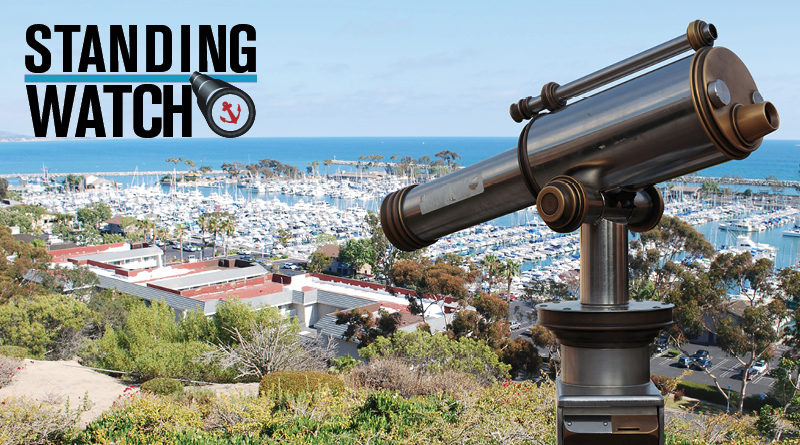Harmful Algal Blooms: Don’t Forget About the West Coast
NOAA will survey Great Lakes, Mid-Atlantic and Gulf of Mexico regions, but what about waterborne pathogens striking California?
NATIONWIDE—East Coast Bias – a phrase commonly heard in the sports realm and often used to explain the phenomenon of extra attention given to Atlantic Seaboard or Northeastern issues, often at the expense of equally or more significant issues on the West Coast. Is the National Oceanic and Atmospheric Administration, or NOAA, guilty of East Coast Bias in conducting a survey of harmful algal bloom episodes in the Mid-Atlantic, Great Lakes and Gulf of Mexico regions, but leaving out waterways in Southern California, Washington and other West Coast locations?
NOAA’s proposal, issued on Jan. 2, specifically seeks information from three locations east of the Mississippi River concerning waterborne pathogens in three major waterways. Last year’s harmful algal bloom events in Florida, for example, received national attention and even spurred federal legislators in Washington, D.C. to take action. NOAA’s recent proposal and request for information – just as the nation’s longest government shutdown was underway, no less – appears to be a continuation of the action legislators spurred last year.
California’s Pacific coast, for some reason, is not included within NOAA’s request – despite scientists at the University of Southern California found harbors between Santa Barbara and San Diego contained the world’s highest concentration of dangerous algal toxins. Such toxins, USC’s scientists stated, posed a direct threat to wildlife and locally caught seafood.
“We are seeing an increase in harmful algal blooms and an increase in severity,” David Caron, a biologist at the USC Dornsife College of Letters, Arts and Sciences, said after the USC survey was published in August 2018. “The Southern California coast really is a hot spot and our study also shows that the concentrations of particulate domoic acid measured in the region are some of the highest – if not the highest – ever reported.”
Caron is also a researcher with the USC Wrigley Institute for Environmental Studies; he co-authored the algal bloom study with postdoctoral researcher Jayme Smith and several others.
The survey found several disturbing results, such as “the world’s highest domoic acid measurement” occuring near San Pedro in March 2011. San Pedro is home to the Los Angeles Harbor and several recreational boating marinas. The domoic acid levels were at 52.3 micrograms per liter then, roughly five times higher than the usual level of concern, according to USC’s researchers.
“Domoic acid in shellfish can occur at high concentrations off the coast of San Diego, Orange and Los Angeles counties, but it tends to be more prevalent in Ventura and Santa Barbara counties due to local environmental conditions,” the researchers continued.
The USC study broadly observed the spreading of harmful algal bloom events along the North American coast, from Central California to Alaska, since 2016.
Six people and 12 animals fell ill due to harmful algal blooms in California last year, according to the state’s Water Board – and not all events occurred on the ocean. An August 2018 NBC4 report on algal bloom events stated Southern California’s Lake Elsinore was too dangerous for human contact – specifically because of harmful algal blooms.
A portion of Channel Islands Harbor in Oxnard also suffered from an algal bloom event in mid-2018. Red tides and other algal bloom events have off-and-on occurred in San Diego during the past few years, as well.
NOAA, meanwhile, hopes to collect information from stakeholders at Chesapeake Bay, the Gulf of Mexico and Lake Erie in an attempt to mitigate the effects of harmful algal blooms and waterborne pathogens.
“Harmful algal blooms (HABs) and waterborne pathogens … have caused major health, ecological, and economic concerns. HABs and other waterborne pathogens can lead to a number of impacts including impaired drinking water, reduced recreational opportunities, and human health impacts from either ingesting affected fish/water or contact with the bloom,” NOAA staff stated in its Federal Register documentation on the proposed survey.
The federal agency, to be fair, would use the sample information collected in the Great Lakes, Gulf of Mexico and Mid-Atlantic to further develop its harmful algal bloom forecast products, which would be offered nationwide. Such a product (or products) would conceivably be beneficial to waterways in California (and the state’s neighbors).
Yet are all algal bloom events the same? Can NOAA truly develop a nationwide product to address harmful algal bloom events without including West Coast waterways in its proposed survey? Are harmful algal bloom events mitigated the same way in California as they are in, say, Texas or Florida or Maryland or Michigan? How would we know the answer to these questions without including at least one West Coast waterway in the NOAA survey?


